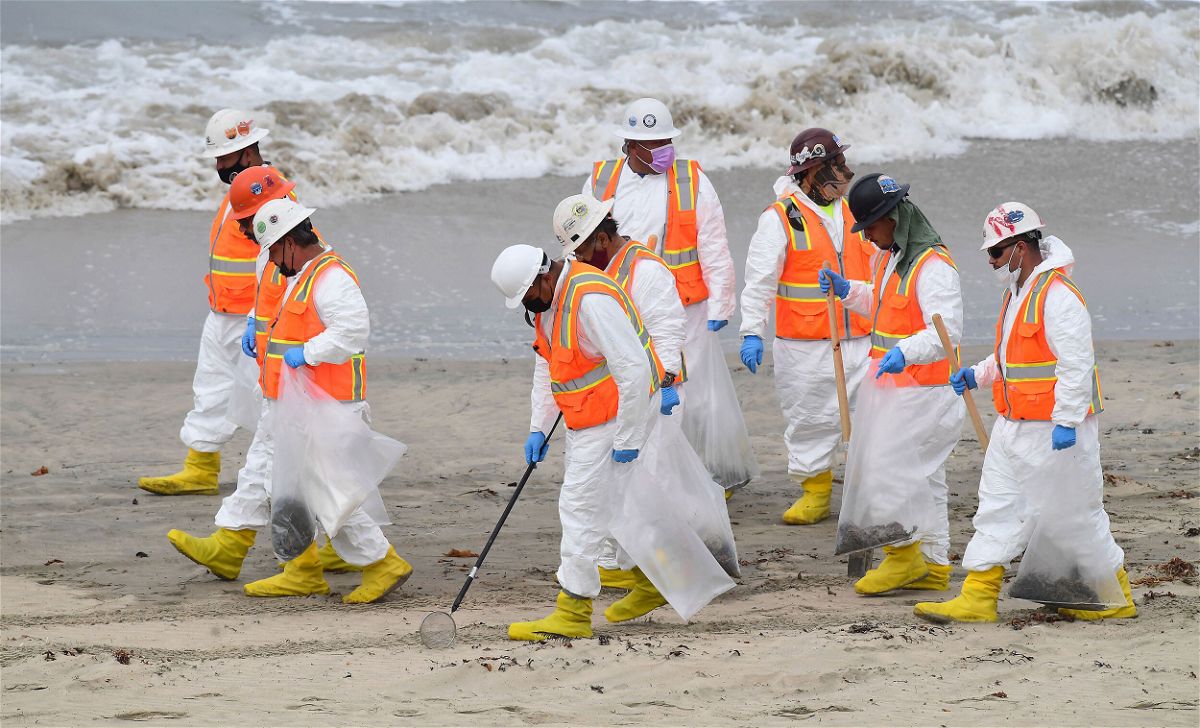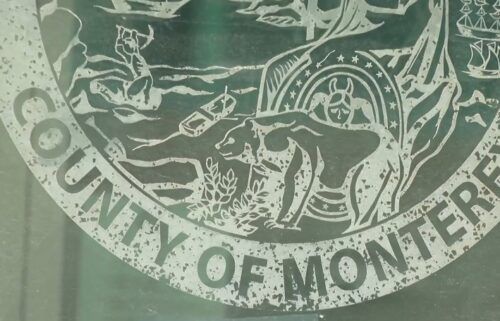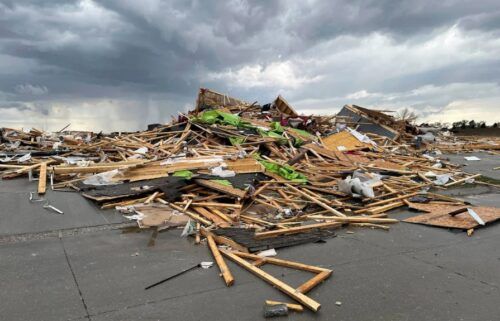Pipeline crack in California oil spill may have occurred up to a year ago, investigators say

A cleanup crew works on the beach on Thursday
By Dakin Andone, Mallika Kallingal and Sarah Moon, CNN
Investigators say the pipeline which caused thousands of gallons of crude oil to spill into the Pacific Ocean off the coast of Orange County, California, may have been displaced several months to a year ago.
The pipeline was intact in October 2020 before it was deflected by 105 feet, eventually leading to damage to its casing and a crack, according to Jason Neubauer, chief of the office of investigations and analysis for the US Coast Guard.
They still believe the 13-inch linear crack on the pipeline was likely caused by a ship’s anchor dragging along the sea floor. “I’m convinced that the initial event that deflected the pipe itself was an anchor strike,” Neubauer confirmed Friday, as he released new details in the probe of the incident.
Video released Thursday by the Coast Guard showed marine growth on the damaged portion of the pipeline, which was initially enclosed in concrete. Neubauer explained the linear fracture on the pipeline could have been a very gradual crack, which got worse over time.
“This event could be multiple incidents and strikes on the pipeline after the initial event, that we’re pretty confident occurred several months to a year ago,” Neubauer said.
Sifting a year’s worth of data
Investigators are now sifting through a year’s worth of data and images from multiple sources, including marina exchange vessel traffic service, to determine when the oil spill first started. They will also be looking at every vessel movement over the pipeline over the course of the entire year.
“We are not ready to rule out any vessels as a contributing cause to this incident,” Neubauer stated.
Investigators will also examine geological events, including a heavy weather event in mid-January, which may have contributed to the crack. A section of the pipe will be taken to the National Transportation Safety Board lab, so investigators can determine when and how the leak occurred.
While similar anchor strikes have happened over the past 10 years, Neubauer said there was only one event that led to an oil spill, which he called a “rare occurrence.”
Meanwhile, Orange County officials continue to ask residents and visitors to avoid the ocean water and oiled areas of the beaches. According to the Orange County Health Care Agency, air samples from areas potentially impacted by the oil spill are within background levels and below state health standards for the pollutants measured.
“We are very encouraged by the early results of the air quality sampling,” Orange County health officer Dr. Clayton Chau said in a statement. But he added the original health advisory remains in place as cleanup efforts continue.
Environmental impact
Tar balls, possibly linked to the oil spill, are still washing up on San Diego beaches, county officials said Thursday, highlighting concerns about the widening environmental impacts.
“While it is not impossible for this to occur naturally, the quantity is highly unlikely, highly unusual, and it is very likely that these tar balls are in fact the result of the oil spill,” San Diego County Board of Supervisors Chair Nathan Fletcher said in a news conference Thursday.
“We do not know that for certain yet,” he added. Officials have collected samples, which are being tested.
San Diego County will declare a state of emergency if the tar balls are tied to the Orange County oil spill, Fletcher said. Booms — floating barriers used to contain an oil spill — have been deployed out of an abundance of caution, he said.
The news comes days after the first reports of the spill, which forced the closure of beaches and threatened coastal habitats after oil leaked into the ocean from a split, or partial tear, in a pipeline several miles offshore. Authorities said earlier this week the source appeared to be a 13-inch split found in a 4,000-foot section of pipe owned by Amplify Energy.
According to Fletcher, lifeguards from the cities of Carlsbad and Oceanside saw the tar balls on their beaches Wednesday night, and officials have also received reports of tar balls in Encinitas and Del Mar, some 70 miles south of the beaches initially impacted in Orange County. About 13 barrels of tar balls were recovered Thursday.
There is no immediate threat to public health, Fletcher said, and the beaches will remain open until further notice. But officials have asked people to be on the lookout for the tar balls.
In the meantime, officials continue their own cleanup efforts in Orange County, where nearly 1,500 people are expected to help out this weekend, Orange County Second District Supervisor Katrina Foley said on Twitter.
People should not approach any oiled animals, she added, but call the Oiled Wildlife Care Network (OWCN).
According to OWCN, as of Thursday evening, the number of wildlife recovered in the response totaled 35, including 10 birds recovered dead.
The oil spill has been designated a “Major Marine Casualty,” the US Coast Guard announced Thursday, the highest level of severity. In this case, it’s been designated as such “due to the potential involvement of a vessel and the resulting damages estimated in excess of $500,000,” the Coast Guard said in a statement.
Authorities say approximately 172,500 lbs of oily debris have been recovered from the shoreline.
A class action lawsuit was filed against Amplify Energy and affiliated corporations Thursday on behalf of business owners impacted by the oil spill, claiming the companies failed to safely maintain the pipeline.
CNN has contacted Amplify Energy, which operated the pipeline believed to be the source of the spill, for comment on the lawsuit, and is awaiting its reply.
Thousands of gallons of oil released into Pacific
While the exact number is not known, officials said in a news conference Thursday they estimate at least 24,000 gallons and possibly as much as 131,000 gallons of crude oil were released into the Pacific Ocean. US Coast Guard Captain Rebecca Ore said the worst-case scenario would put the figure at a maximum of 131,628 gallons, or 3,134 barrels.
A joint investigation between the US Coast Guard and other officials continues to move forward, Ore said.
A preliminary report indicated the partial tear could have been caused by a vessel’s anchor hooking the pipeline. Earlier this week, the US Coast Guard boarded a German cargo ship anchored in waters off Southern California when the pipeline began spilling crude oil into the ocean.
On Friday, a spokesperson for the ship’s operator said the ship was not under investigation, adding the Coast Guard had given the vessel permission to leave port.
The-CNN-Wire
™ & © 2021 Cable News Network, Inc., a WarnerMedia Company. All rights reserved.



